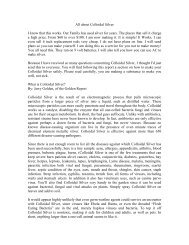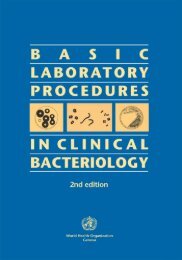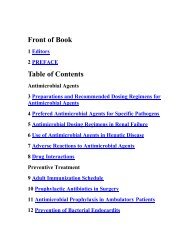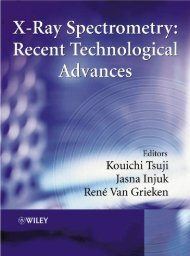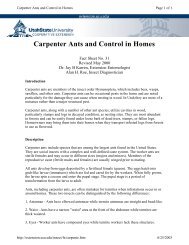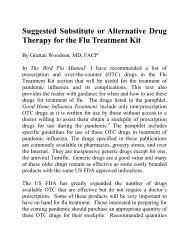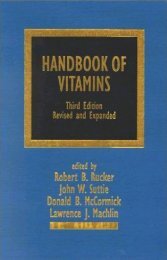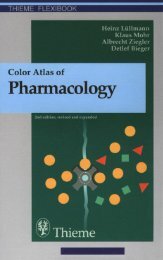- Page 2 and 3:
The Nutritional Biochemistryof Chro
- Page 4 and 5:
The NutritionalBiochemistry ofChrom
- Page 6 and 7: Table of ContentsPrefaceContributor
- Page 8 and 9: PrefaceThe manufacture and sale of
- Page 10 and 11: Prefaceixdiscuss the implications o
- Page 12 and 13: ContributorsD. BagchiInterHealth Re
- Page 14 and 15: Chapter 1Introduction: A history of
- Page 16 and 17: Introduction: A history of chromium
- Page 18 and 19: Introduction: A history of chromium
- Page 20 and 21: Introduction: A history of chromium
- Page 22 and 23: Introduction: A history of chromium
- Page 24 and 25: Introduction: A history of chromium
- Page 26 and 27: Introduction: A history of chromium
- Page 28 and 29: Introduction: A history of chromium
- Page 30 and 31: Introduction: A history of chromium
- Page 32 and 33: Introduction: A history of chromium
- Page 34 and 35: Introduction: A history of chromium
- Page 36 and 37: Introduction: A history of chromium
- Page 38 and 39: Introduction: A history of chromium
- Page 40 and 41: Introduction: A history of chromium
- Page 42 and 43: Introduction: A history of chromium
- Page 44 and 45: Introduction: A history of chromium
- Page 46 and 47: Introduction: A history of chromium
- Page 48 and 49: Introduction: A history of chromium
- Page 50 and 51: Introduction: A history of chromium
- Page 52 and 53: Introduction: A history of chromium
- Page 54 and 55: Part IChromium as a nutrient and nu
- Page 58 and 59: Basis for dietary recommendations f
- Page 60 and 61: Basis for dietary recommendations f
- Page 62 and 63: Basis for dietary recommendations f
- Page 64 and 65: Basis for dietary recommendations f
- Page 66 and 67: Basis for dietary recommendations f
- Page 68 and 69: Basis for dietary recommendations f
- Page 70 and 71: Chapter 3Multiple hypotheses for ch
- Page 72 and 73: Multiple hypotheses for chromium(II
- Page 74 and 75: Multiple hypotheses for chromium(II
- Page 76 and 77: Multiple hypotheses for chromium(II
- Page 78 and 79: Multiple hypotheses for chromium(II
- Page 80 and 81: Multiple hypotheses for chromium(II
- Page 82 and 83: Multiple hypotheses for chromium(II
- Page 84 and 85: Chapter 4Effects of chromium(III) a
- Page 86 and 87: Effects of chromium(III) as a nutri
- Page 88 and 89: Effects of chromium(III) as a nutri
- Page 90 and 91: Effects of chromium(III) as a nutri
- Page 92 and 93: Effects of chromium(III) as a nutri
- Page 94 and 95: 79 M, 16 F Cr(pic) 3 , 400 Yes 16 R
- Page 96 and 97: Effects of chromium(III) as a nutri
- Page 98 and 99: Chapter 5Use of chromium as an anim
- Page 100 and 101: Use of chromium as an animal feed s
- Page 102 and 103: Use of chromium as an animal feed s
- Page 104 and 105: Use of chromium as an animal feed s
- Page 106 and 107:
Use of chromium as an animal feed s
- Page 108 and 109:
Use of chromium as an animal feed s
- Page 110 and 111:
Use of chromium as an animal feed s
- Page 112 and 113:
Use of chromium as an animal feed s
- Page 114 and 115:
Use of chromium as an animal feed s
- Page 116 and 117:
Use of chromium as an animal feed s
- Page 118 and 119:
Use of chromium as an animal feed s
- Page 120 and 121:
Use of chromium as an animal feed s
- Page 122 and 123:
Use of chromium as an animal feed s
- Page 124 and 125:
Use of chromium as an animal feed s
- Page 126 and 127:
Use of chromium as an animal feed s
- Page 128 and 129:
Use of chromium as an animal feed s
- Page 130 and 131:
Use of chromium as an animal feed s
- Page 132 and 133:
Part IIBiochemical role(s) for chro
- Page 134 and 135:
Chapter 6The transport of chromium(
- Page 136 and 137:
The transport of chromium(III) in t
- Page 138 and 139:
The transport of chromium(III) in t
- Page 140 and 141:
The transport of chromium(III) in t
- Page 142 and 143:
The transport of chromium(III) in t
- Page 144 and 145:
The transport of chromium(III) in t
- Page 146 and 147:
The transport of chromium(III) in t
- Page 148 and 149:
The transport of chromium(III) in t
- Page 150 and 151:
The transport of chromium(III) in t
- Page 152 and 153:
Chapter 7Potential and purported ro
- Page 154 and 155:
Potential and purported roles for c
- Page 156 and 157:
Potential and purported roles for c
- Page 158 and 159:
Potential and purported roles for c
- Page 160 and 161:
Potential and purported roles for c
- Page 162 and 163:
Potential and purported roles for c
- Page 164 and 165:
Potential and purported roles for c
- Page 166 and 167:
Potential and purported roles for c
- Page 168 and 169:
Potential and purported roles for c
- Page 170 and 171:
Potential and purported roles for c
- Page 172 and 173:
Potential and purported roles for c
- Page 174 and 175:
Part IIIChromium(III) as a therapeu
- Page 176 and 177:
Chapter 8Clinical effect of chromiu
- Page 178 and 179:
Table 1Comparison of chromium studi
- Page 180 and 181:
Clinical effect of chromium supplem
- Page 182 and 183:
Clinical effect of chromium supplem
- Page 184 and 185:
Clinical effect of chromium supplem
- Page 186 and 187:
Clinical effect of chromium supplem
- Page 188 and 189:
Clinical effect of chromium supplem
- Page 190 and 191:
Clinical effect of chromium supplem
- Page 192 and 193:
Clinical effect of chromium supplem
- Page 194 and 195:
Clinical effect of chromium supplem
- Page 196 and 197:
Chapter 9Benefits of chromium(III)
- Page 198 and 199:
Benefits of chromium(III) complexes
- Page 200 and 201:
Benefits of chromium(III) complexes
- Page 202 and 203:
Benefits of chromium(III) complexes
- Page 204 and 205:
Benefits of chromium(III) complexes
- Page 206 and 207:
Benefits of chromium(III) complexes
- Page 208 and 209:
Benefits of chromium(III) complexes
- Page 210 and 211:
Benefits of chromium(III) complexes
- Page 212 and 213:
Benefits of chromium(III) complexes
- Page 214 and 215:
Benefits of chromium(III) complexes
- Page 216 and 217:
Benefits of chromium(III) complexes
- Page 218 and 219:
Benefits of chromium(III) complexes
- Page 220 and 221:
Part IVToxicological effects of chr
- Page 222 and 223:
Chapter 10Evaluation of chromium(II
- Page 224 and 225:
Evaluation of chromium(III) genotox
- Page 226 and 227:
Evaluation of chromium(III) genotox
- Page 228 and 229:
Evaluation of chromium(III) genotox
- Page 230 and 231:
Evaluation of chromium(III) genotox
- Page 232 and 233:
Evaluation of chromium(III) genotox
- Page 234 and 235:
Evaluation of chromium(III) genotox
- Page 236 and 237:
Evaluation of chromium(III) genotox
- Page 238 and 239:
Chapter 11Redox chemistry and biolo
- Page 240 and 241:
Redox chemistry and biological acti
- Page 242 and 243:
Redox chemistry and biological acti
- Page 244 and 245:
Redox chemistry and biological acti
- Page 246 and 247:
Redox chemistry and biological acti
- Page 248 and 249:
Redox chemistry and biological acti
- Page 250 and 251:
Redox chemistry and biological acti
- Page 252 and 253:
Redox chemistry and biological acti
- Page 254 and 255:
Redox chemistry and biological acti
- Page 256 and 257:
Redox chemistry and biological acti
- Page 258 and 259:
Redox chemistry and biological acti
- Page 260 and 261:
Redox chemistry and biological acti
- Page 262 and 263:
Redox chemistry and biological acti
- Page 264 and 265:
Redox chemistry and biological acti
- Page 266 and 267:
Redox chemistry and biological acti
- Page 268 and 269:
Redox chemistry and biological acti
- Page 270 and 271:
Chapter 12Overview of chromium(III)
- Page 272 and 273:
Overview of chromium(III) toxicolog
- Page 274 and 275:
Overview of chromium(III) toxicolog
- Page 276 and 277:
Overview of chromium(III) toxicolog
- Page 278 and 279:
Chapter 13Summary: The clinical and
- Page 280 and 281:
Summary: The clinical and nutrition
- Page 282 and 283:
Summary: The clinical and nutrition
- Page 284 and 285:
Summary: The clinical and nutrition
- Page 286 and 287:
Summary: The clinical and nutrition
- Page 288 and 289:
Summary: The clinical and nutrition
- Page 290 and 291:
IndexAbsorption of chromium, 25, 51
- Page 292 and 293:
Index 279Low-molecular-weight chrom



